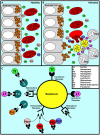The battle for iron between bacterial pathogens and their vertebrate hosts
- PMID: 20711357
- PMCID: PMC2920840
- DOI: 10.1371/journal.ppat.1000949
The battle for iron between bacterial pathogens and their vertebrate hosts
Conflict of interest statement
The author has declared that no competing interests exist.
Figures

References
-
- Bullen JJ, Griffiths E. Iron and infection: molecular, physiological and clinical aspects. New York: John Wiley and Sons; 1999.
-
- Ganz T, Nemeth E. Regulation of iron acquisition and iron distribution in mammals. Biochim Biophys Acta. 2006;1763:690–699. - PubMed
-
- Bullen JJ, Spalding PB, Ward CG, Gutteridge JM. Hemochromatosis, iron and septicemia caused by Vibrio vulnificus. Arch Intern Med. 1991;151:1606–1609. - PubMed
-
- Crosa JH, Mey AR, Payne SM, editors. Iron transport in bacteria. Washington (D.C.): ASM Press; 2004. 499
Publication types
MeSH terms
Substances
Grants and funding
LinkOut - more resources
Full Text Sources
Other Literature Sources
Medical

